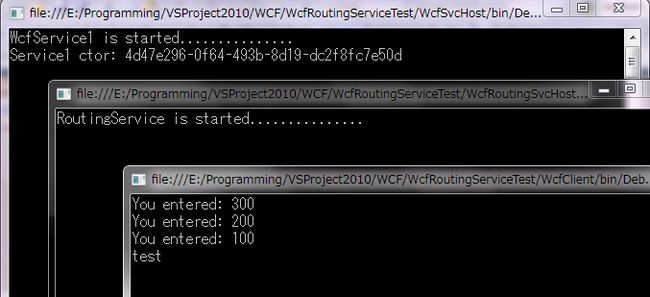WCF4.0 —— Routing Service
现在WCF 4.0内置了路由服务——System.ServiceModel.Routing.RoutingService,可以在 System.ServiceModel.Routing.dll 中找到。
比如下面的场景会使用到路由服务:只暴露一个外部公开的 Endpoint 映射到内部的多个的服务上。
路由服务使用的消息筛选器提供常用消息选择功能,例如,终结点的名称、SOAP 操作或消息已发送到的地址或地址前缀。也可以使用 AND 条件连接筛选器,这样,仅当消息同时与两个筛选器匹配时,才会将消息路由至某个终结点。此外,还可以通过创建自己的 MessageFilter 实现来创建自定义筛选器。(MSDN:消息筛选器)
OK,废话少说下面做一个实例来看看 RoutingService 该如何配置。
1. Console Hosting Request/Reply WCF Service Routing (示例代码下载)
(1) 创建一个普通的Wcf Service Library (使用Console Hosting)
Console Host
static void Main(string[] args)
{
using (var host = new ServiceHost(typeof(WcfSvcLib.Service1)))
{
host.Open();
Console.WriteLine("WcfService1 is started...............");
Console.Read();
}
}
app.config<system.serviceModel>
<services>
<service name="WcfSvcLib.Service1" behaviorConfiguration="WcfSvcLib.Service1Behavior">
<host>
<baseAddresses>
<add baseAddress="http://localhost:20000/WcfRoutingServiceTest/Service1/"/>
</baseAddresses>
</host>
<endpoint name="WcfService1" address="" binding="wsHttpBinding" contract="WcfSvcLib.IService1">
<identity>
<dns value="localhost"/>
</identity>
</endpoint>
<endpoint address="mex" binding="mexHttpBinding" contract="IMetadataExchange"/>
</service>
</services>
<behaviors>
<serviceBehaviors>
<behavior name="WcfSvcLib.Service1Behavior">
<serviceMetadata httpGetEnabled="True"/>
<serviceDebug includeExceptionDetailInFaults="False"/>
</behavior>
</serviceBehaviors>
</behaviors>
</system.serviceModel>
为了测试,Service1 使用的是 PerSession,当 Service1 被第一次调用时,服务端构造一次 Service1 实例。并在之后的调用中保持该 Session。
SetName 将保存一个值,GetName 则取出该值。
namespace WcfSvcLib
{
[ServiceBehavior(InstanceContextMode=InstanceContextMode.PerSession)]
public class Service1 : IService1
{
private string _name = "";
public Service1()
{
Console.WriteLine("Service1 ctor: " + Guid.NewGuid().ToString());
}
public string GetData(int value)
{
return string.Format("You entered: {0}", value);
}
public void SetName(string name)
{
_name = name;
}
public string GetName()
{
return _name;
}
}
}
(2) 创建 Wcf Routing Service Host (使用Console Hosting)首先添加 System.ServiceModel.Routing.dll, using System.ServiceModel.Routing;
static void Main(string[] args)
{
using (var host = new ServiceHost(typeof(RoutingService)))
{
try
{
host.Open();
Console.WriteLine("RoutingService is started...............");
Console.Read();
}
catch (Exception ex)
{
Console.WriteLine(ex.Message);
}
Console.Read();
}
}
重点在于 RoutingService 的配置文件,详细参看代码中的注释说明。
<?xml version="1.0"?>
<configuration>
<system.web>
<compilation debug="true"/>
</system.web>
<system.serviceModel>
<services>
<!-- 定义 Routing Service 的地址(baseAddress+endpoint address),
绑定(wsHttpBinding),契约(System.ServiceModel.Routing.IRequestReplyRouter) -->
<!-- 注意:Routing Service 的契约必须和被路由服务的模型吻合比如:
Request/Reply 模式,OneWay 模式,或者是 Duplex 模式。这里是 Request/Reply 模式 -->
<service name="System.ServiceModel.Routing.RoutingService" behaviorConfiguration="MyRoutedServBehavior">
<host>
<baseAddresses>
<add baseAddress="http://localhost:20002/WcfRoutingServiceTest/router"/>
</baseAddresses>
</host>
<endpoint address="service1" binding="wsHttpBinding" name="MyRoutingEndpoint" contract="System.ServiceModel.Routing.IRequestReplyRouter"/>
</service>
</services>
<!-- 在 serviceBehavior 中加入了 routing 配置节,指明使用的 filterTableName -->
<behaviors>
<serviceBehaviors>
<behavior name="MyRoutedServBehavior">
<serviceMetadata httpGetEnabled="True"/>
<serviceDebug includeExceptionDetailInFaults="True"/>
<routing filterTableName="ServiceRouterTable"/>
</behavior>
</serviceBehaviors>
</behaviors>
<routing>
<!-- filterTable 中配置了 filter 和 client endpoint 的映射关系 -->
<!-- 注意:当使用 Request/Reply 模型时,filterTable 里不能有多个 Endpoint
(详细参看:http://msdn.microsoft.com/zh-cn/library/ee816891.aspx 的多播一节)-->
<filterTables>
<filterTable name="ServiceRouterTable">
<add filterName="ServiceRouter_Filter1" endpointName="WcfService1"/>
<!--
<add filterName="ServiceRouter_Filter2" endpointName="WcfService1"/>
<add filterName="ServiceRouter_Filter3" endpointName="WcfService1"/>
-->
</filterTable>
</filterTables>
<filters>
<!-- 配置 filter:-->
<!-- filterType 有:MatchAll, Action, EndpointAddress, EndpointAddressPrefix, EndpointName, XPath, Custom, And-->
<!-- (1) MatchAll 时,filterData 就无视了,直接转发给真实的 Endpoint -->
<!-- (2) Action 时,filterData 里填写的内容应该是 "协议://Namespace(注1)/ServiceContractName/OperationContractName" -->
<!-- (3) EndpointAddress,filterData 里填写的某服务的URL,比如:"http://<主机名>/vdir/s.svc/b"-->
<!-- (4) EndpointAddressPrefix, 和(3)EndpointAddress类似,顾名思义地址前缀匹配,比如:""http://<主机名>/vdir/s.svc"-->
<!-- (5) EndpointName, 比写全地址更灵活且不容易出错(service 配置节里的 EndpoingName) -->
<!-- (6) XPath, 功能较上面更为强大,通过对 soap 消息的 XPath 定义匹配 -->
<!-- (7) Custom, 自定义过滤器通过继承:CustomAssembly.MyCustomMsgFilter MessageFilter 重写 Match 方法实现 -->
<!-- (8) And 不直接筛选消息中的值,而是通过它组合两个其他筛选器来创建 AND 条件 -->
<!-- 例如:<filter name="and1" filterType="And" filter1="address1" filter2="action1" /> -->
<filter name="ServiceRouter_Filter1" filterType="MatchAll" />
<!--
<filter name="ServiceRouter_Filter2" filterType="Action" filterData="http://tempuri.org/IService1/GetName"/>
<filter name="ServiceRouter_Filter3" filterType="Action" filterData="http://tempuri.org/IService1/SetName"/>
-->
</filters>
</routing>
<!-- client 配置节配置了路由服务要转发的真实服务地址 -->
<client>
<endpoint
name="WcfService1" binding="wsHttpBinding"
address="http://localhost:20000/WcfRoutingServiceTest/Service1/"
contract="*">
</endpoint>
</client>
</system.serviceModel>
<startup><supportedRuntime version="v4.0" sku=".NETFramework,Version=v4.0"/></startup></configuration>
(3) 创建客户端应用首先是客户端代理的生成,通过 Wcf Routing Service 好像没有办法能访问到真实服务的wsdl,
因此我的做法是先利用真实服务的wsdl生成代理,然后修改客户端配置文件。
比如这个例子中真实服务地址是:http://localhost:20000/WcfRoutingServiceTest/Service1
Wcf Routing Service的地址是: http://localhost:20002/WcfRoutingServiceTest/router/service1
修改后的客户端配置如下:
<?xml version="1.0" encoding="utf-8" ?>
<configuration>
<system.serviceModel>
<client>
<endpoint address="http://localhost:20002/WcfRoutingServiceTest/router/service1"
binding="wsHttpBinding" contract="WcfService1.IService1" name="WcfService1" >
<identity>
<dns value="localhost" />
</identity>
</endpoint>
</client>
</system.serviceModel>
</configuration>
客户端调用:static void Main(string[] args)
{
using (var client = new WcfService1.Service1Client())
{
var result = client.GetData(300);
Console.WriteLine(result);
result = client.GetData(200);
Console.WriteLine(result);
result = client.GetData(100);
Console.WriteLine(result);
client.SetName("test");
Console.WriteLine(client.GetName());
Console.Read();
}
}
(4) 运行
运行结果显示,client -> Routing Service -> Wcf Service1 注意当PerSession时,如果在RoutingService 每个filter 对于 WcfService1 都是独立的Session。
http://topic.csdn.net/u/20111005/15/69a4c0b8-63ab-4528-a520-6a8568ee17d3.html
----------------------------- 分割线 ----------------------------
2. IIS Hosting Request/Reply WCF Service Routing (示例代码下载)
当使用IIS Hosting时,我们创建的 WCF 工程模板就需要改为 Wcf Service Application了。下面介绍如何配置 Wcf Service Application 中的 Routing Service
这次需要实现的是在一个 Routing Service 中路由多个不同地址的 Wcf Service (如文章开头的图片所示)
(1) Solution Overview
其中:
WcfRoutingService : http://localhost:20001/RoutingService.svc
WcfService1 : http://localhost:20002/Service1.svc
WcfService2: http://localhost:20003/Service1.svc
(2) 配置 WcfRoutingService
因为 WcfRoutingService 里没有任何 svc 文件,这里利用了 WCF 4.0 的无 svc 文件激活服务的新特性:
<serviceHostingEnvironment multipleSiteBindingsEnabled="true">
<serviceActivations>
<add relativeAddress="RoutingService.svc"
service="System.ServiceModel.Routing.RoutingService,
System.ServiceModel.Routing, version=4.0.0.0, Culture=neutral,
PublicKeyToken=31bf3856ad364e35" />
</serviceActivations>
</serviceHostingEnvironment>
另外,上面已经提到对于 WCF Request/Reply 模型的 filterTable 不允许多播,那么在 Routing Service 里,需要配置响应个数的 Endpoint完整配置如下:
<?xml version="1.0"?>
<configuration>
<system.web>
<compilation debug="true" targetFramework="4.0" />
</system.web>
<system.serviceModel>
<bindings>
<wsHttpBinding>
<binding name="NonSecurityBinding">
<security mode="None" />
</binding>
</wsHttpBinding>
</bindings>
<serviceHostingEnvironment multipleSiteBindingsEnabled="true">
<serviceActivations>
<add relativeAddress="RoutingService.svc"
service="System.ServiceModel.Routing.RoutingService,
System.ServiceModel.Routing, version=4.0.0.0, Culture=neutral,
PublicKeyToken=31bf3856ad364e35" />
</serviceActivations>
</serviceHostingEnvironment>
<services>
<service name="System.ServiceModel.Routing.RoutingService" behaviorConfiguration="RoutingSvcBehaviorConfig">
<endpoint address="service1" binding="basicHttpBinding" name="service1Endpoint" contract="System.ServiceModel.Routing.IRequestReplyRouter"/>
<endpoint address="service2" binding="basicHttpBinding" name="service2Endpoint" contract="System.ServiceModel.Routing.IRequestReplyRouter"/>
</service>
</services>
<behaviors>
<serviceBehaviors>
<behavior name="RoutingSvcBehaviorConfig">
<serviceMetadata httpGetEnabled="True"/>
<serviceDebug includeExceptionDetailInFaults="True"/>
<routing filterTableName="ServiceRoutingTable" soapProcessingEnabled="true" />
</behavior>
</serviceBehaviors>
</behaviors>
<routing>
<filterTables>
<!-- endprointName 对应上面 service/endpoint/name -->
<filterTable name="ServiceRoutingTable">
<add filterName="Service1Filter" endpointName="WcfService1" />
<add filterName="Service2Filter" endpointName="WcfService2" />
</filterTable>
</filterTables>
<filters>
<filter name="Service1Filter" filterType="EndpointName" filterData="service1Endpoint" />
<filter name="Service2Filter" filterType="EndpointName" filterData="service2Endpoint" />
</filters>
</routing>
<client>
<endpoint name="WcfService1" binding="basicHttpBinding" address="http://localhost:20002/Service1.svc" contract="*" />
<endpoint name="WcfService2" binding="basicHttpBinding" address="http://localhost:20003/Service2.svc" contract="*" />
</client>
</system.serviceModel>
<system.webServer>
<modules runAllManagedModulesForAllRequests="true"/>
</system.webServer>
</configuration>
(3) 创建客户端应用客户端配置文件
<?xml version="1.0"?>
<configuration>
<system.serviceModel>
<bindings>
<basicHttpBinding>
<binding name="BasicHttpBinding_IService1" />
<binding name="BasicHttpBinding_IService2" />
<binding name="service1Endpoint" />
</basicHttpBinding>
</bindings>
<client>
<endpoint address="http://localhost:20001/RoutingService.svc/service1"
binding="basicHttpBinding" bindingConfiguration="BasicHttpBinding_IService1"
contract="WcfService1.IService1" name="service1Endpoint" />
<endpoint address="http://localhost:20001/RoutingService.svc/service2"
binding="basicHttpBinding" bindingConfiguration="BasicHttpBinding_IService2"
contract="WcfService2.IService2" name="service2Endpoint" />
</client>
</system.serviceModel>
<startup><supportedRuntime version="v4.0" sku=".NETFramework,Version=v4.0"/></startup></configuration>
调用static void Main(string[] args)
{
// Test for WcfService1
using (var service1client = new WcfService1.Service1Client("service1Endpoint"))
{
var result = service1client.GetData(300);
Console.WriteLine(result);
}
// Test for WcfService2
using (var service2client = new WcfService2.Service2Client("service2Endpoint"))
{
var result = service2client.GetData(100);
Console.WriteLine(result);
}
Console.Read();
}
(4) 运行
----------------------------- 分割线 ----------------------------
http://msdn.microsoft.com/zh-cn/library/ee517419.aspx
http://blogs.profitbase.com/tsenn/?p=23
http://msdn.microsoft.com/zh-cn/library/ee517425.aspx